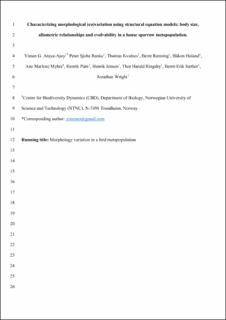Characterizing morphological (co)variation using structural equation models: Body size, allometric relationships and evolvability in a house sparrow metapopulation
Araya-Ajoy, Yimen; Ranke, Peter Sjolte; Kvalnes, Thomas; Rønning, Bernt; Holand, Håkon; Myhre, Ane Marlene; Pärn, Henrik; Jensen, Henrik; Ringsby, Thor Harald; Sæther, Bernt-Erik; Wright, Jonathan
Peer reviewed, Journal article
Accepted version

Åpne
Permanent lenke
https://hdl.handle.net/11250/2649006Utgivelsesdato
2019Metadata
Vis full innførselSamlinger
- Institutt for biologi [2575]
- Publikasjoner fra CRIStin - NTNU [38127]
Sammendrag
Body size plays a key role in the ecology and evolution of all organisms. Therefore, quantifying the sources of morphological (co)variation, dependent and independent of body size, is of key importance when trying to understand and predict responses to selection. We combine structural equation modeling with quantitative genetics analyses to study morphological (co)variation in a meta‐population of house sparrows (Passer domesticus). As expected, we found evidence of a latent variable “body size,” causing genetic and environmental covariation between morphological traits. Estimates of conditional evolvability show that allometric relationships constrain the independent evolution of house sparrow morphology. We also found spatial differences in general body size and its allometric relationships. On islands where birds are more dispersive and mobile, individuals were smaller and had proportionally longer wings for their body size. Although on islands where sparrows are more sedentary and nest in dense colonies, individuals were larger and had proportionally longer tarsi for their body size. We corroborated these results using simulations and show that our analyses produce unbiased allometric slope estimates. This study highlights that in the short term allometric relationships may constrain phenotypic evolution, but that in the long term selection pressures can also shape allometric relationships.